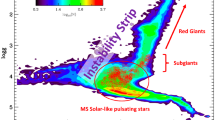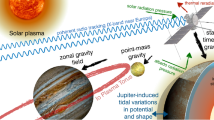Abstract
The inner core has a differential rotation relative to the crust and mantle, the relative linear velocity between the solid inner core and the molten outer core is the biggest at the equator and zero at pole area. As a result, the inner core grows faster at the equator than at the pole area. The gravitational force drives the material flow from the equator to the pole area and makes the inner core remain quasi-orbicular. The corresponding axial symmetric stress field makesc-axes of hexagonal close packed (hcp) iron align with inner core’s rotation axis, resulting in observed seismic anisotropy.
Similar content being viewed by others
References
Stixrude, L., Cohen, R. E., High-pressure elasticity of iron and anisotropy of earth’s inner core, Science, 1995, 267: 1972.
Sayers, C. M., The crystal structure of iron in the Earth’s inner core, Geophys. J. Int., 1990, 103: 285.
Yoshida, S., Sumita, I., Kumazawa, M., Growth model of the inner core coupled with the outer core dynamics and the resulting elastic anisotropy, J. Geophy. Res., 1996, 101(B12): 28085.
Stixrude, L., Cohen, R. E., Constraints on the crystalline structure of the inner core: Mechanical instability of BCC iron at high pressure, Geophysical Res. Lett., 1995, 22(2): 125.
Boehler, R., Bargen, N., Chopelas, A., Melting, thermal expansion, and phase transitions of iron at high pressures, J. Geophy. Res., 1990, 95(B13): 21731.
Wenk, H-R., Preferred Orientation in Deformed Metals and Rocks: An Introduction to Modern Texture Analysis, New York: Academic Press, Inc., 1985, 220.
Song, X., Richards, P. G., Seismological evidence for differential rotation of the Earth’s inner core, Nature, 1996, 382: 221.
Su, W., Dziewonski, A. M., Jeanloz, R., Planet within a planet: Rotation of the inner core of Earth, Science, 1996, 274: 1883.
Pamplin, B. R., Crystal Growth, London: Pergamon Press, 1981, 146.
Kamb, W. B., Theory of preferred crystal orientation developed by crystallization under stress, J. Geol., 1959, 67: 153.
Kamb, W. B., The thermodynamic theory of nonhydrostatically stressed solids, J. Geophys. Res., 1961, 66: 259.
Gubbins, D., Observational constraints on the generation process of the Earth’s magnetic field, Geophys. J., 1976, 47: 19.
Author information
Authors and Affiliations
About this article
Cite this article
Liu, B., Zhang, Q., Wang, B. et al. Inner core’s seismic anisotropy is related to its rotation. Chin.Sci.Bull. 45, 751–753 (2000). https://doi.org/10.1007/BF02886184
Received:
Issue Date:
DOI: https://doi.org/10.1007/BF02886184




